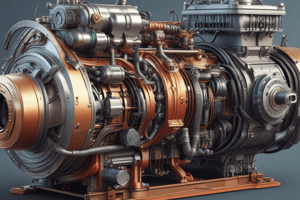Podcast
Questions and Answers
What is the primary function of the stator in an AC motor?
What is the primary function of the stator in an AC motor?
- To rotate the load
- To produce a rotating magnetic field (correct)
- To convert DC to AC
- To connect to the load
What is the principle behind the operation of an AC motor?
What is the principle behind the operation of an AC motor?
- Electromagnetic induction (correct)
- Electrostatic induction
- Mechanical induction
- Thermal induction
What determines the synchronous speed of an AC motor?
What determines the synchronous speed of an AC motor?
- The frequency of the AC supply and the number of poles (correct)
- The rotor's magnetic field
- The load connected to the motor
- The stator's magnetic field
What is the purpose of slip in an AC motor?
What is the purpose of slip in an AC motor?
What is the air gap in an AC motor?
What is the air gap in an AC motor?
What is the direction of the force experienced by the rotor due to the rotating magnetic field?
What is the direction of the force experienced by the rotor due to the rotating magnetic field?
Study Notes
Principles of Operation
Basic Components
- Stator: stationary part of the motor, consisting of a magnetic field
- Rotor: rotating part of the motor, connected to the load
- Air gap: small gap between the stator and rotor
Operating Principle
- AC motor works on the principle of electromagnetic induction
- Alternating current (AC) flows through the stator windings, producing a rotating magnetic field
- The rotor, being a conductor, experiences a force when it interacts with the rotating magnetic field
- The direction of the force depends on the direction of the magnetic field and the rotor's velocity
Torque Production
- Torque is produced when the rotor's magnetic field interacts with the stator's magnetic field
- The rotor's magnetic field is induced by the stator's magnetic field
- The torque produced causes the rotor to rotate
Synchronous Speed
- Synchronous speed is the speed at which the rotor would rotate if it were perfectly synchronized with the rotating magnetic field
- The synchronous speed is determined by the frequency of the AC supply and the number of poles in the motor
- The rotor's actual speed is always less than the synchronous speed due to slip
Slip
- Slip is the difference between the synchronous speed and the rotor's actual speed
- Slip is necessary for the production of torque in an AC motor
- The amount of slip determines the motor's efficiency and power output
Basic Components of AC Motor
- Stator is the stationary part of the motor, consisting of a magnetic field
- Rotor is the rotating part of the motor, connected to the load
- Air gap is the small gap between the stator and rotor
Operating Principle of AC Motor
- AC motor works on the principle of electromagnetic induction
- Alternating current (AC) flows through the stator windings, producing a rotating magnetic field
- The rotor, being a conductor, experiences a force when it interacts with the rotating magnetic field
- The direction of the force depends on the direction of the magnetic field and the rotor's velocity
Torque Production in AC Motor
- Torque is produced when the rotor's magnetic field interacts with the stator's magnetic field
- The rotor's magnetic field is induced by the stator's magnetic field
- The torque produced causes the rotor to rotate
Synchronous Speed and Slip
- Synchronous speed is the speed at which the rotor would rotate if it were perfectly synchronized with the rotating magnetic field
- Synchronous speed is determined by the frequency of the AC supply and the number of poles in the motor
- Rotor's actual speed is always less than the synchronous speed due to slip
- Slip is the difference between the synchronous speed and the rotor's actual speed
- Slip is necessary for the production of torque in an AC motor
- Amount of slip determines the motor's efficiency and power output
Studying That Suits You
Use AI to generate personalized quizzes and flashcards to suit your learning preferences.
Description
Learn about the basic components and operating principles of AC motors, including the stator, rotor, and air gap, and how electromagnetic induction works.




